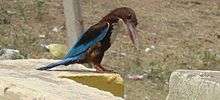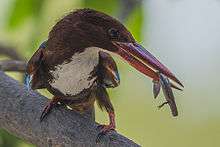White-throated kingfisher
| White-throated kingfisher | |
|---|---|
_Photograph_by_Shantanu_Kuveskar.jpg) | |
| H. smyrnensis subsp. fusca in India | |
| Scientific classification | |
| Kingdom: | Animalia |
| Phylum: | Chordata |
| Class: | Aves |
| Family: | Alcedinidae |
| Subfamily: | Halcyoninae |
| Genus: | Halcyon |
| Species: | H. smyrnensis |
| Binomial name | |
| Halcyon smyrnensis Linnaeus, 1758 | |
| | |
| distribution | |
The white-throated kingfisher (Halcyon smyrnensis) also known as the white-breasted kingfisher or Smyrna kingfisher, is a tree kingfisher,[2] widely distributed in Asia from Turkey east through the Indian subcontinent to the Philippines. This kingfisher is a resident over much of its range, although some populations may make short distance movements. It can often be found well away from water where it feeds on a wide range of prey that includes small reptiles, amphibians, crabs, small rodents and even birds. During the breeding season they call loudly in the mornings from prominent perches including the tops of buildings in urban areas or on wires.
Description
This is a large kingfisher, 28 cm in length. The adult has a bright blue back, wings and tail. Its head, shoulders, flanks and lower belly are chestnut, and the throat and breast are white. The large bill and legs are bright red. The flight of the white-throated kingfisher is rapid and direct, the short rounded wings whirring. In flight, large white patches are visible on the blue and black wings. Sexes are similar, but juveniles are a duller version of the adult.
This species forms a superspecies with Halcyon cyanoventris and most major works recognize four geographic races. They vary clinally in size, the shades of blue on the mantle which is more greenish in smyrnensis and fusca and more blue or purplish in saturatior.
- smyrnensis (Linnaeus, 1758) is found in Turkey, Northern and Central Israel,[3] Egypt, Iraq, Pakistan, Afghanistan, northwestern India, China, Taiwan and the Philippines, south of Thailand, West Malaysia, Singapore, Sumatra and Java.
- fusca (Boddaert, 1783) is found in India, Sri Lanka, South China, Taiwan, Sumatra and West Java. Population from Burma to the Greater Sundas were treated under the name perpulchra but are now lumped into fusca. South China and Taiwanese populations are sometimes treated as subspecies fokiensis.
- saturatior Hume, 1874 is found in the Andaman Islands.
- gularis (Kuhl, 1820) is found in the Philippines.
H. s. gularis of the Philippines has only the neck and throat white. It is sometimes treated as a distinct species, H. gularis. Race fusca is found in Peninsular India and Sri Lanka and is slightly smaller, bluer and with a darker brown underside than the nominate race found in northwestern India. Race saturatior is found in the Andaman Islands and is larger with darker brown underparts. Race perpulchra (not always recognized) is found in northeastern India and is smaller than fusca with paler underparts.[4] Albinism has been noted on occasion.[5]
The English of white-throated was introduced since the range is large and geographic adjectives would make the name too restrictive, while the older name of white-breasted would not describe the eastern race which has only the throat white.
The call of this kingfisher is a chuckling chake-ake-ake-ake-ake. They are particularly noisy in the breeding season.
Local names include Baluchistan: aspi chidok; Sindhi: dalel; Hindi: kilkila, kourilla; Himachal Pradesh: neela machhrala; Punjabi: wadda machhera; Bengali: sandabuk machhranga; Assamese: masroka; Cachar: dao natu gophu; Gujarati: kalkaliyo, safedchati kalkaliyo; Marathi: khandya; Tamil: vichuli; Telugu: lakmuka, buchegadu; Malayalam: ponman; Kannada: rajamatsi; Sinhalese: pilihuduwa.[6]
Habitat and distribution
White-throated kingfisher is a common species of a variety of habitats, mostly open country in the plains (but has been seen at 7500 ft in the Himalayas[7]) with trees, wires or other perches. The range of the species is expanding.
This kingfisher is widespread and populations are not threatened. Average density of 4.58 individuals per km2. has been noted in the Sundarbans mangroves.[8]
Behaviour and ecology
Feeding and diet
It perches conspicuously on wires or other exposed perches within its territory, and is a frequent sight in south Asia. This species mainly hunts large crustaceans,[9] insects, earthworms,[10] rodents, snakes, fish and frogs.[11][12] Predation of small birds such as the Oriental white-eye, chick of a red-wattled lapwing, sparrows and munias have been reported.[13][14][15] The young are fed mostly on invertebrates.[16] In captivity, it has been noted that it rarely drinks water although bathing regularly.[17]
Breeding
The white-throated kingfisher begins breeding at the onset of the Monsoons. Males perch on prominent high posts in their territory and call in the early morning. The tail may be flicked now and in its courtship display the wings are stiffly flicked open for a second or two exposing the white wing mirrors. They also raise their bill high and display the white throat and front. The female in invitation makes a rapid and prolonged kit-kit-kit... call. The nest is a tunnel (50 cm long, but a nest with a 3-foot tunnel has been noted[18]) in an earth bank. The nest building begins with both birds flying into a suitable mud wall until an indentation is made where they can find a perch hold. They subsequently perch and continue digging the nest with their bills. Nest tunnels in a haystack have also been recorded.[19] A single clutch of 4-7 round white eggs is typical. The eggs take 20–22 days to hatch while the chicks fledge in 19 days.[13][20][21]
Movements
Birds have sometimes been seen attracted to lights at night, especially during the monsoon season, suggesting that they are partly migratory.[13]
Mortality

With a powerful bill and rapid flight, these kingfishers have few predators when healthy and rare cases of predation by a black kite[22] and a jungle crow may be of sick or injured birds.[23] An individual found dead with its beak embedded into the wood of a tree has been suggested as an accident during rapid pursuit of prey, possibly an Oriental white-eye.[15] A few parasites have been noted.[24]
In the 1800s these birds were hunted for their bright feathers that were used to adorn hats.[25]
References
- ↑ BirdLife International (2012). "Halcyon smyrnensis". IUCN Red List of Threatened Species. Version 2013.2. International Union for Conservation of Nature. Retrieved 26 November 2013.
- ↑ Fry; Fry & Harris. Kingfishers, Bee-eaters and Rollers. ISBN 0-7136-8028-8.
- ↑ Arnold, Paula: Birds of Israel, (1962), Shalit Publishers Ltd., Haifa, Israel. p. 12
- ↑ Rasmussen, PC & JC Anderton (2005). Birds of South Asia. The Ripley Guide. Smithsonian Institution and Lynx Edicions.
- ↑ Gunawardana, Jagath (1993). "Description of an albino White-breasted Kingfisher (Halcyon smyrnensis).". Ceylon Bird Club Notes (June): 56–57.
- ↑ Anonymous (1998). "Vernacular Names of the Birds of the Indian Subcontinent" (PDF). Buceros. 3 (1): 53–109.
- ↑ Khacher, Lavkumar J (1970). "Notes on the White-eye (Zosterops palpebrosa) and Whitebreasted Kingfisher (Halcyon smyrnensis).". J. Bombay Nat. Hist. Soc. 67 (2): 333.
- ↑ Reza AHMA; MM Feeroz; MA Islam & MMKabir (2003). "Status and density of kingfishers (family: Alcedinidae, Halcyonidae and Cerylidae) in the Sundarbans mangrove forest, Bangladesh" (PDF). Bangladesh J. Life Sci. 15 (1): 55–60.
- ↑ Tehsin, Raza (1995). "Crab-eating by Whitebreasted Kingfisher Halcyon smyrnensis (Linn.).". J. Bombay Nat. Hist. Soc. 92 (1): 121.
- ↑ Yahya, HSA; Yasmin,Shahla (1991). "Earthworms in the dietary of the Whitebreasted Kingfisher Halcyon smyrnensis (Linn.).". J. Bombay Nat. Hist. Soc. 88 (3): 454.
- ↑ Roberts,T J; Priddy,C (1965). "Food of the Whitebreasted Kingfisher Halcyon smyrnensis (Linnaeus).". J. Bombay Nat. Hist. Soc. 62 (1): 152–153.
- ↑ Tehsin ,Raza (1989). "Feeding behaviour of Whitebreasted Kingfisher Halcyon smyrnensis (Linnaeus).". J. Bombay Nat. Hist. Soc. 86 (3): 449.
- 1 2 3 Ali, S & S Dillon Ripley (1983). Handbook of the birds of India and Pakistan. 4 (2nd ed.). Oxford University Press. pp. 90–93.
- ↑ Sen, SN (1944). "Food of the White-breasted Kingfisher (Halcyon smyrnensis fusca)". J. Bombay Nat. Hist. Soc. 44 (3): 475.
- 1 2 Purandare, Kiran Vasant (2008). "Freak accidental death of a White-breasted Kingfisher Halcyon smyrnensis. Indian Birds". 4 (1).
- ↑ Burton NHK (1998). "Notes on the diet of nestling White-throated Kingfishers Halcyon smyrnensis in Malaysia" (PDF). Forktail. 14: 79–80.
- ↑ Harper, EW. "The White-breasted Kingfisher Halcyon smyrnensis in captivity.". J. Bombay Nat. Hist. Soc. 13 (2): 364–365.
- ↑ Law, SC (1925). "Nesting habits of the Indian Whitebreasted Kingfisher Halcyon smyrnensis fusca.". J. Bombay Nat. Hist. Soc. 30 (2): 477–478.
- ↑ Balasubramanian,P (1992). "New nesting site of the Indian Whitebreasted Kingfisher Halcyon smyrnensis fusca (Boddaert).". J. Bombay Nat. Hist. Soc. 89 (1): 124.
- ↑ Palkar SB; RJ Lovalekar & VV Joshi (2009). "Breeding biology of White-breasted Kingfisher Halcyon smyrnensis.". Indian Birds. 4 (3): 104–105.
- ↑ Hume, AO (1890). The nests and eggs of Indian birds. 3 (2nd ed.). R H Porter, London. pp. 15–19.
- ↑ Narayanan, E (1989). "Pariah Kite Milvus migrans capturing Whitebreasted Kingfisher Halcyon smyrnensis.". J. Bombay Nat. Hist. Soc. 86 (3): 445.
- ↑ Balasubramanian, P. (1990). "Behaviour of southern spotted owlet Athene brama brama (Temminck) and jungle crow (Temminck) and jungle crow Corvus macrorhynchos at Point Calimere, Tamil Nadu.". J. Bombay Nat. Hist. Soc. 87 (1): 145.
- ↑ Nandi AP; De NC; Majumdar G (1985). "Records of two new nematodes (Acuariidae) parasitizing kingfishers (Coraciiformes) of West Bengal India". Helminthologia. 22 (3): 161–170.
- ↑ Lockwood, Edward (1878). Natural history, sport and travel. W H Allen and Co. pp. 185–186.
Other sources
- Mohanty, Banalata (2006). "Extracellular Accumulations in the Avian Pituitary Gland: Histochemical Analysis in Two Species of Indian Wild Birds.". Cells Tissues Organs. 183 (2): 99–106. doi:10.1159/000095514. PMID 17053326.
- Oommen, M; Andrews, MI (1996). "Awakening, roosting and vocalization behaviour of the Whitebreasted Kingfisher Halcyon smyrnensis fusca (Boddaert).". Pavo. 34 (1&2): 43–46.
- Oommen, M; Andrews, MI (1993). "Breeding biology of the Whitebreasted Kingfisher, Halcyon smyrnensis". In Verghese,A; Sridhar,S; Chakravarthy,AK. Bird Conservation: Strategies for the Nineties and Beyond. Ornithological Society of India, Bangalore. pp. 177–180.
- Ticehurst, CB (1927). "Remarks on races of Halcyon smyrnensis and descriptions of two new subspecies - Zosterops palpebrosa occidentis and Z.P. nilgiriensis.". Bull. Brit. Orn. Club. 47 (312): 87–90.
- Oommen, M; Andrews,MI (1998) Food and feeding habits of the Whitebreasted Kingfisher Halcyon smyrnensis. Chap. 19. In: Birds in Agricultural Ecosystem. (Eds: Dhindsa,MS; Rao,P Syamsunder; Parasharya,BM) Society for Applied Ornithology, Hyderabad, 132-136.
External links
| Wikimedia Commons has media related to Halcyon smyrnensis. |
- White-throated kingfisher videos, photos & sounds on the Internet Bird Collection
- Singapore birds

